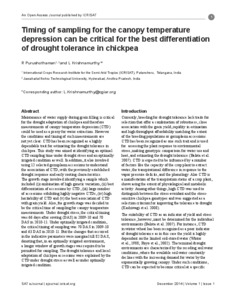Timing of sampling for the canopy temperature depression can be critical for the best differentiation of drought tolerance in chickpea
Abstract
Maintenance of water supply during grain filling is critical for the drought adaptation of chickpea and therefore measurements of canopy temperature depression (CTD) could be used as a proxy for water extraction. However the conditions and timing of such measurements are not yet clear. CTD has been recognized as a highly dependable trait for estimating the drought tolerance in chickpea. This study was aimed at identifying an optimal CTD sampling time under drought stress and an optimally irrigated condition as well. In addition, it also involved using 12 selected germplasm accessions to understand the association of CTD, with the previously established drought response and early rooting characteristics. The growth stage involved identifying a sample which included (i)combination of high genetic variation, (ii) best differentiation of accessions by CTD, (iii) large number of accessions exhibiting highly negative CTDs, (iv) high heritability of CTD and (v) the best association of CTD with grain yield. Also, the growth stage was decided to be the critical time of sampling for canopy temperature measurements. Under drought stress, the critical timing was 66 days after sowing (DAS) in 2009-10 and 70 DAS in 2010-11. Under optimally irrigated condition, the critical timing of sampling was 70 DAS in 2009-10 and 63 DAS in 2010-11. But the changes that occurred in the indicative parameters were marginal till 82 DAS, denoting that, in an optimally irrigated environment, a longer window of growth stages was required to be permitted for sampling. The drought tolerance and local adaptation of chickpea accessions were explained by the CTD under drought stress as well as under optimally irrigated condition

